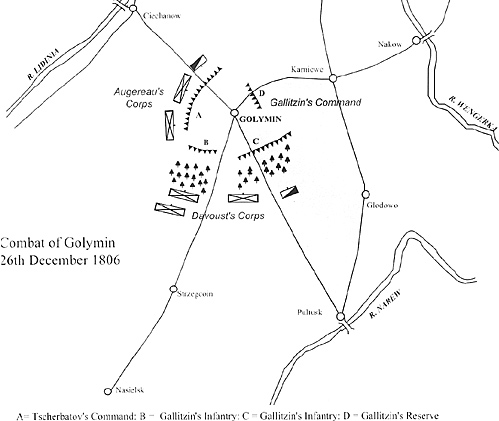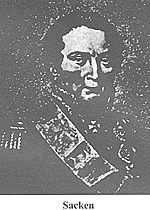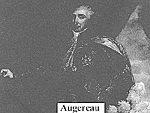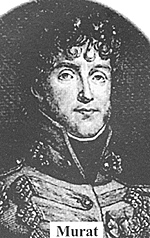The Action of Golymin
26th December 1806
by Patrick Wilson, UK
| |
The action of Golymin came about as General Count Wilhelm Buxhowdenís Army retreated before the advance of Napoleonís Grande Armťe. Indeed, Napoleon himslf actually hoped that a large-scale battle would be fought that day at Golymin rather than Pultusk, where one did actually occur. Prince Gallitzin's job that day was to cover the retreat of Buxhowdenís Army. To do this he had General Baron Sackenís 3rd Division, part of his own and part of General Doctorovís in, around and marching for Golymin.
The town was a crossroads of importance to Buxhowdenís Army as it withdrew. This withdrawal was the consequence of earlier fighting along the river Narew as Marechalís Augereau and Davoust forced their way across. The fighting had been severe and Napoleon had consequently hoped to profit from it in forcing the Russians to fight a battle before the Polish winter set in. Unfortunately the thaw and muddy nature of the Polish roads was undermining French efforts. It was with the utmost difficulty that they managed to bring a single cannon forward. [1]
The Russians themselves had to abandon many of their cannon because of this [2] and this only added to the difficulties of the French as the abandoned cannon acted as yet more obstacles as they pursued their Russian prey. The action of Gol- ymin occurred as a result of this pursuit and would consequently see much fighting with the bayonet there being few cannons available to either side.
The town of Golymin in 1806 was situated about 12 miles to the north-west of Pultusk. As a position Golymin was one of great strength for defensive action. Though absolutely flat, it was almost entirely surrounded by woods and marshes, the weather of December 1806 also made them very impracticable from a military point of view. The outer edge of the above mentioned woods give way to an open marshy plain over which the French would have to pass if they wished to take Golymin, the plain was dotted with a few hamlets, Ruskowo, Wadkowo and Kaleczin.
The Russians under Prince Gallitzin had taken up positions to defend Golymin with a detachment under Major-General Tscherbatow holding Kaleczin. Prince Gallitzin had Sackenís 3rd division, part of his own and part of Doctorovís division. The rest of Gallitzinís own division actually took part in the Battle of Pultusk. The rest of General Doctorovís division had already retreated to safety at Makow as ordered by General Kamenskoi, the Russian supreme commander who was soon to be replaced by Benningsen.
The action that was about to be fought took place under similar weather conditions to those experienced by the Battle of Pultusk. The weather being, how can one put it, bloody
awful! The forces were, in strength, opposite those of Pultusk, the Russians being greatly outnumbered by about two to one. Though the Russians were thought to have had 50,000 men by Marechal Joachim Murat [3] such was the valour of their resistance to the French attack.
The first French to arrive opposite Price Gallitzinís positions belonged to Marechal Pierre Augereauís Corps. Augereau (at right) attacked from the west of the position, directing one division under General Heudelet to attack from the left via Wadkowo (a hamlet Heudelet occupied without difficulties) and the other under General Desjardins to move forward from
Ruskowo against Golymin itself. Unable to count on the support of their artillery Augereauís divisions made little progress against Prince Gallitzinís improvised positions and their spirited defenders. General Heudelet found himself under constant attack from Russian cavalry as he advanced from Wadkowo to Golymin, which forced him to keep his troops
in squares and consequently his advance slowed to a snails pace. General Desjardinís division got on slightly better, attacking with greater elan, it at first drove back Major-General Tscherbatowís infantry but Prince Gallitzin reinforced his lieutenant.
Tscherbatow then put himself at the head of his men and counter-attacked, driving Desjardins' division from all the ground it had just taken. General Desjardins quickly rallied his men and took them forward again, this time though they were halted by the Russian grapeshot at 50 paces. With his 2nd brigade decimated by this unexpected act, General Desjardins had no choice but to retire 200 yards and like Heudelet form square as he too was engulfed by Russian cavalry which seemed to be all over the place.
This was actually the end of the Marechal Augereauís role in the fight for Golymin as fighting had flared up on another sector and apart from skirmishing little of consequence
occurred now on this sector of the field as Augereauís divisions were effectively pinned down by Russian cavalry and artillery. Prince Gallitzin meanwhile had transferred some of his infantry against the new threat and in doing so Marechal Augereauís aide-de-camp Marbot recorded thatÖ ďAlthough our soldiers fired at the enemy from a range of 25 paces the latter continued their journey (across Augereauís front) without replying, for to do so would have necessitated a halt, and every moment was too precious to lose.
Each division, each regiment, filed across in this way under our fusillade without saying a word and without slowing their pace for an instant. The streets of Golymin were heaped with dying and wounded, but we heard not a single groan Ė they were forbidden to make a sound!Ē [4] Marechal Joachim Murat (at right) and Louis Davoust were now upon the field of conflict and attacking from the south.
Muratís cavalry, General Kleinís Dragoons and General Milhaudís Chasseurs a Cheval, were the first to arrive and drive back the Russian cavalry towards the woods about Golymin. Marechal Davoustís own cavalry under General Marulaz joined Muratís shortly after this but the French cavalry were unable to advance further because of the woods and had to await the arrival of Davoustís leading infantry division under General Comte Morand.
Prince Gallitzin had been warned of the Marechalís approach, and as related so elegantly by Marbot, had moved troops into the woods on his left to oppose them. General Comte Morand eventually arrived to support the French cavalrymen but only began his attack at 3.30pm with his 1st brigade, again like Augereau, he had been unable to bring his artillery up because of the muddy nature of the ground. Morand led his infantry (13th Legere) in battalion columns and was soon engaged in mortal combat with Gallitzinís battalions, who
fighting with their favourite weapon, the bayonet, fought with a desperate courage but it was not enough as Morandís men eventually drove them out off the woods and only the dead and dying remained together with 400 knapsacks that had been abandoned during the fighting and marked the position of Gallitzinís battalions.
Having taken the woods the French then sought to continue the attack into Golymin but they were to be thwarted. As Muratís cavalry surged forward over what they now perceived
as open ground, the Russians revealed a trap. The ground on this side of the wood was marshy and therefore when the French cavalry attempted to ride down what they thought were badly deployed infantry they were decimated by its fire. General Rapp, an imperial aide-de-camp leading the French cavalry was wounded. The Russian infantry were standing up to their waists in marsh and safe from any cavalry attack. General Morand on seeing the hasty flight of his comrades in the cavalry thought better of an attack with his 2nd brigade and was happy to have secured the woods. Whilst the Russians under Prince Gallitzin commenced their retreat on Makow. It was to 9.00pm before the last of the weary troops had left Golymin.
Prince Gallitzin, though it was difficult, actually managed to take what guns he had with him! Losses had been about 1,000 on either side, it had been a tough engagement for both. Smaller then the Battle of Pultusk it never the less reflected well upon the professional skill of Prince Gallitzin and the bravery, endurance and stoicism of the ordinary Russian soldier. The action of Golymin enabled Buxhowdenís Army to continue its retreat unmolested upon Makow as well as giving the French food for thought. Prince Gallitzin had handled his command well, the French attacks were a little disjointed (Augereauís attack had been more or less defeated by the time Davoust arrived).
The action of Golymin, together with the battle of Pultusk destroyed Napoleonís expectations of the Manoeuvre of the Narew. [5]
It also meant that Napoleon had to fight another two campaigns, the horrific Preussisch-Eylau campaign that almost destroyed his army and the equally tough though victorious campaign of Friedland.
[1] Petre, Loraine F., Napoleonís campaign in Poland 1806-07, p.93
Prince Gallitzin
3rd Division: Lt-Genl Baron Sacken
Brigade Baron Korf:
Brigade Uschakov:
Brigade Netting:
From General Doctorovís division:
Marechal Joachim Murat, Grand Duc of Berg.
7th Corps díArmťe: Marechal Pierre Augereau
Division Desjardins
Division Heudelet
Corps Cavalry Genl. Durosnel
Artillery reserve
Genl. Comte Morandís Division
1st Brigade díHonnieres
Reserve Cavalry
Division Klein
Brigade Fenerolz
Brigade Milhaud
Chandler, David g., Napoleonís Campaigns, (London: Weidenfeld & Nicolson, 1987 edition)
|
 In an earlier article for First Empire, I wrote about General Count Levin Benningsenís triumph at the Battle of Pultusk over the Roland of the Grande Armťe, Marechal Jean Lannes. That very same day however, another Russian general, Prince Gallitzin, fought an equally honourable combat at Golymin against Marechal Pierre Augereauís Corps and a division of Marechal Louis Davoustís Corps. The odds were very unequal as Prince Gallitzin had but a Russian division supported by a few detachments, whilst the French had at their disposal at least three infantry divisions and one cavalry division. True, the muddy nature of the ground and thaws of that December favoured the defence and restricted the offensive but the odds were high and the Princeís performance that day only added lustre to the reputation of the Russian Army.
In an earlier article for First Empire, I wrote about General Count Levin Benningsenís triumph at the Battle of Pultusk over the Roland of the Grande Armťe, Marechal Jean Lannes. That very same day however, another Russian general, Prince Gallitzin, fought an equally honourable combat at Golymin against Marechal Pierre Augereauís Corps and a division of Marechal Louis Davoustís Corps. The odds were very unequal as Prince Gallitzin had but a Russian division supported by a few detachments, whilst the French had at their disposal at least three infantry divisions and one cavalry division. True, the muddy nature of the ground and thaws of that December favoured the defence and restricted the offensive but the odds were high and the Princeís performance that day only added lustre to the reputation of the Russian Army.
 Sacken
Sacken
 Augereau Arrives
Augereau Arrives
 Murat Arrives
Murat Arrives